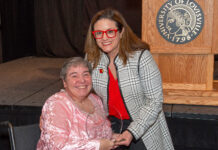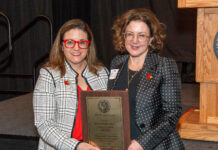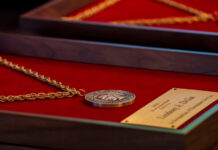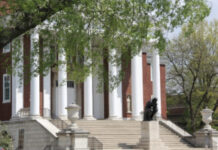His siblings tell him that his mother would take him as a very young child to nearby Gaulbert Street in Louisville to see the trains go by.
Later, after moving to the Crescent Hill area, he and his playmates would stop their sandlot ball games in a field by the railroad tracks to watch the trains pass.
The allure of trains, Castner said, is partly in the movement, the sounds and the experience of riding them.
If one grew up as I did in the era of steam locomotives, the sound that it made, the drama of its passing, particularly if it was running fast, piqued people’s interest, he said.
Castner turned his interest in trains into a career and has continued to develop it and help others in retirement as a volunteer at the University of Louisville’s University Archives and Records Center (UARC).
In late October, the Kentucky State Historical Records Advisory Board (SHRAB) gave him its first certificate of merit for notable service to and advocacy of archives in Kentucky by a private citizen.
Charlie could be the poster person for this award, said SHRAB representative Mary Margaret Bell in presenting the certificate to him. He has been here working every week for 21 years. He is a valuable resource.
His UARC volunteer work wasn’t really planned, said Castner, who retired from L&N Railroad (now part of CSX) as regional manager for corporate communications in 1988.
In 1975, he had arranged with UARC to have the L&N minute books microfilmed for preservation and use by future researchers. In subsequent years he helped broker the transfer of several hundred cubic feet of L&N records, maps, blueprints, photographs, employee magazines and other materials to UARC.
The materials filled about 250 boxes, so upon retirement, Castner decided he’d lend a hand in organizing them for public use.
My intent then was just to come out for a couple of months to help them with the collection, he said. They assigned one of the archivists to do the physical inventory and organization of the collection.
She did the heavy lifting in terms of cataloguing and organizing the collection. I came out on Fridays, he said.
And he still does.
On a recent Friday afternoon, Castner was busy researching the history of a railroad bell given to a West Tennessee church. It was among some 400 bells the railroad gave to churches when steam engines were discontinued, he explained to an interested reporter. The L&N collection likely has specific information on the train engine from which it came.
Most of the inquiries Castner receives are from rail fans who want information on a particular locomotive, an engine type or old passenger trains. Communities, he said, often ask about the trains that ran through them or about their stations’ histories, and he also fields a fair number of genealogical and biographical questions.
The L&N employee magazine provides much of that information, he said.
Castner wrote freelance articles for the magazine in the 1950s while still a producer and writer for Louisville’s WHAS radio. He began his L&N career in 1961 as one of its staff writers.
The magazine had a section called ‘About the Family’, he said. Before the mergers, (L&N) was like a great big family – but a dispersed family all over the South. There was interest in the company maintaining contact and a familial relationship with employees.
Each of the L&N operating regions sent monthly employee news that included promotions, retirements and deaths. There also would be other features about employees that gave a glimpse into their careers and lives.
That information still is accessible because the magazines are indexed.
In fact the L&N collection, the largest non-university-related UARC collection until the recent acquisition of former Rep. Ron Mazzoli’s papers, has an extensive finding aid. But even that won’t help with all information requests Castner receives.
The most unusual question I got was from some rail fan who wrote, ‘Send me everything you have on the L&N Railroad.’ We have probably now 300 to 350 boxes, plus a number of albums, oversized maps, diagrams and drawings, Castner said.
Much of the collection’s growth is from Castner’s continuing efforts to acquire materials. In fact, he noted at his recognition ceremony that he has heard of more L&N records in South America.
If we turn up another 200 boxes, are we shot on the spot or accepted?
Archivist Tom Owen cautioned Castner as he received the certificate of merit that the recognition was not to be received as a thank you and farewell.
But Castner said he has no plans to leave: I’ll continue to work just as long as I can. I’ve been amazed that year after year there have been these inquiries.
He, himself, still enjoys looking through the photo albums remembering such times as L&N’s 1961 commemoration of the railroad’s role in the American Civil War – his first major project as an employee; or the day he rode an excursion to Nashville on a steam engine and – intentionally or not – it ran out of fuel just north of the city and had to be pushed in by a diesel engine.
It has made a very nice retirement activity to still dabble in railroad records, he said.


























